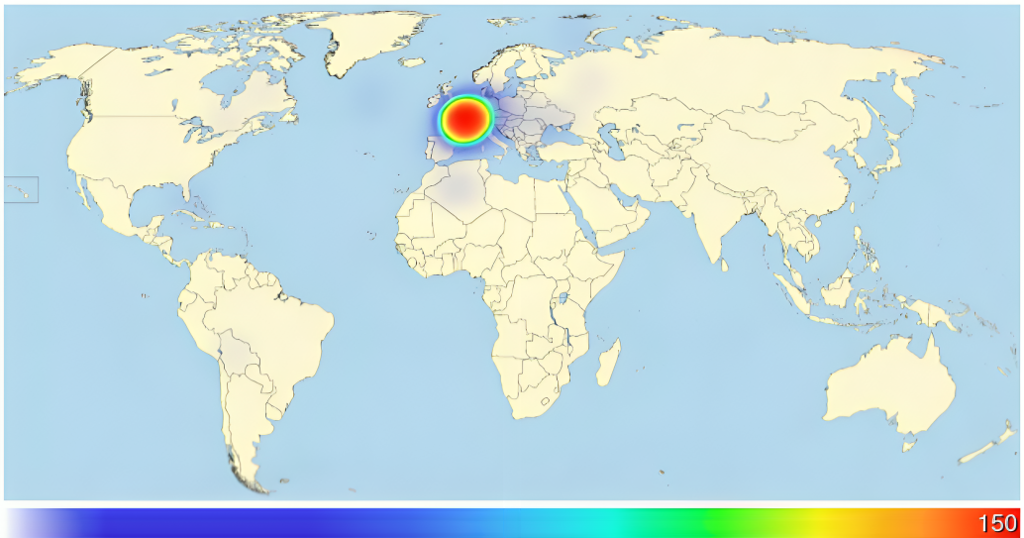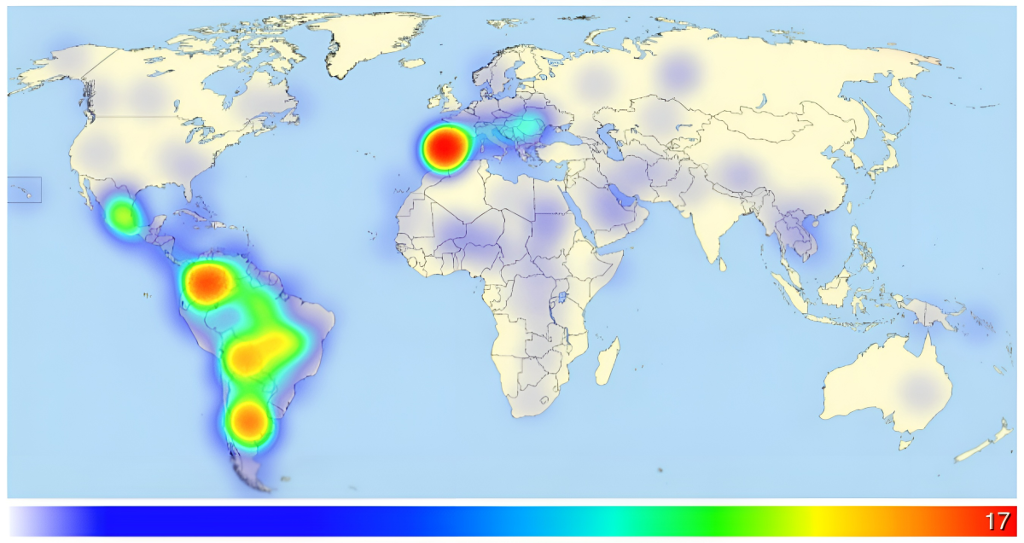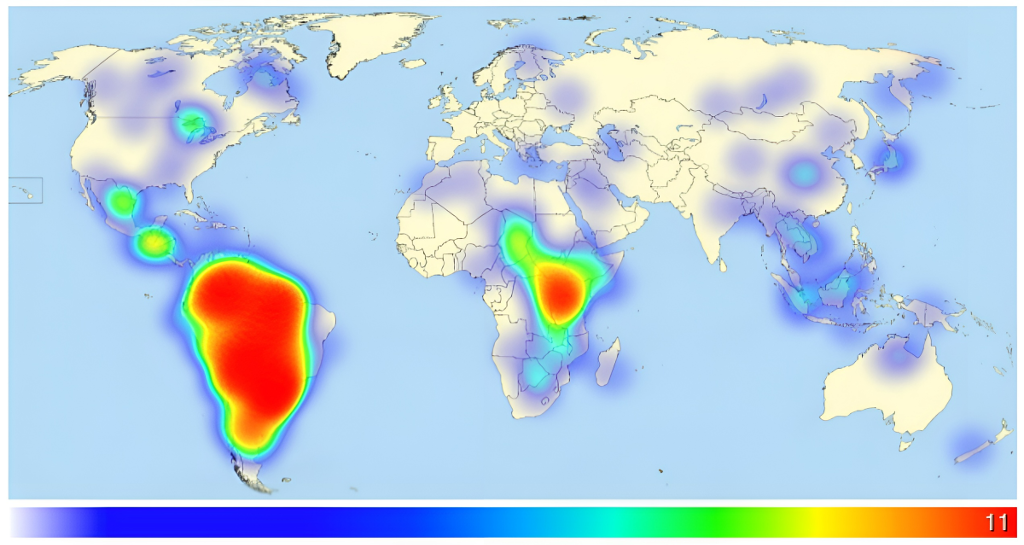We've all had those moments when we look at a map, try to pinpoint the exact location of a place we want to visit, only to realize it's not as straightforward as it seems. Some landmarks stand out on maps like beacons, while others seem to play hide-and-seek with our geographical knowledge.
To discover which landmarks are easiest to locate accurately (and which pose a bigger challenge) we asked 250 participants to identify where various global landmarks and natural wonders are situated on a map.
From the iconic Big Ben to the enigmatic Fiordland National Park, how well do your geo-placing skills measure against the crowd?
Confusing locations: the easiest and hardest landmarks to pinpoint
Here, we’ll be revealing:
The easiest landmarks to place on a map
Some world wonders, such as the mythical Loch Ness in Scotland or the historic Sagrada Familia in Spain, are so universally recognized that their locations are almost impossible to get wrong.
If there's one landmark that effortlessly imprints on the mental maps of people, it's the Eiffel Tower in France. An astonishing 93.3% of participants correctly placed this architectural wonder within a 500-kilometer radius of its real location. Standing tall in the heart of Paris, the Eiffel Tower continues to symbolize the City of Light, love, and romance, with an unmistakable silhouette.
Heatmap of The Eiffel Tower

Also, among the easiest-to-place landmarks is the Italian Colosseum, a testament of ancient Roman architecture, with nearly 86% of people accurately placing it on the map. With incredible historical significance, there have been plenty of recent efforts to restore and preserve this iconic structure for future generations, and it is clearly paying off, at least where cartography is concerned.
The American national treasure, Yellowstone National Park, also earned its place among the top five, with 81.2% of respondents locating it on the map, followed closely by the resounding chimes of Big Ben in London, which 4 out of 5 participants (80.5%) correctly mapped.
Heatmap of Yellowstone National Park

Our study also revealed an intriguing trend: man-made landmarks are significantly easier to locate on a map for most compared to their natural counterparts. Participants had an average percentage of correct answers of nearly 60% for man-made creations, such as architectural marvels and historic sites, while natural sights gained only a 35% identification rate.
Age, it seems, also plays a role in our map-pinpointing abilities. People between 36 and 60 years old have an easier time placing landmarks on a map, averaging 55% correct answers. In contrast, the younger generation (aged 18 to 35) lagged behind, with only 1 in 3 of their answers (32%) being correct.
Rank |
Country |
Landmark Name |
Correct Answers % |
1 |
France |
Eiffel Tower |
93.3% |
2 |
Italy |
Colosseum |
85.7% |
3 |
USA |
Yellowstone National Park |
81.2% |
4 |
UK |
Big Ben |
80.5% |
5 |
UK |
Hadrian's Wall |
77.4% |
=6 |
UK (Scotland) |
Loch Ness |
69.7% |
=6 |
USA |
Grand Canyon |
69.7% |
7 |
UK |
The Kew Royal Botanical Gardens |
69.2% |
8 |
USA |
Statue of Liberty |
67.4% |
=9 |
Greece |
Acropolis of Athens |
65.2% |
10 |
UK |
Windsor Castle |
65.0% |
11 |
China |
Great Wall of China |
59.4% |
12 |
Spain |
The Sagrada Familia |
53.6% |
13 |
Egypt |
Pyramids of Giza |
53.2% |
14 |
Japan |
Mount Fuji |
52.6% |
15 |
UK |
Angel of the North |
51.1% |

#1. The Eiffel Tower

#2. The Colosseum

#3. Yellowstone National Park
The world’s most challenging landmark locations
New Zealand's Fiordland National Park, the Avenue of the Baobabs in Madagascar, and Komodo Island in Indonesia, are just a few of the landmarks that leave even the most seasoned explorers scratching their heads.
The remote wonderland that is New Zealand’s Fiordland National Park takes first place as the most challenging natural wonder to pinpoint. With less than 7% of participants being able to correctly pinpoint it on the world map, this UNESCO World Heritage site is home to rugged mountains, majestic fiords, and nearly untouched wilderness. While a haven for nature enthusiasts, this location seems to elude most.
The Avenue of the Baobabs in Madagascar is the runner up on most challenging locations, as only 8.6% of respondents could correctly identify it on a world map. The avenue, lined with ancient baobab trees, some over 800 years old, is a natural wonder that stands as a testament to Madagascar's unique biodiversity and makes for a photographer's paradise, that is, if you can find it.
Cano Cristales in Colombia and Komodo Island in Indonesia are an elusive duo, with only 9% correct answers. Despite being in South America, and even having a memorable nickname as the "River of Five Colours" due to the vibrant colours of its aquatic plants, a considerable number of participants set Cano Cristales in central Europe.
Heatmap of Cano Cristales

Meanwhile, Komodo Island is famous for its dragon inhabitants, the Komodo dragons. Despite social media fascination with the native reptilian (whose sightings have gathered over 3.1 billion views on TikTok), it seems the destination challenges most when it comes to pinpointing its exact location. Nonetheless, if you manage to make your way to the remote Indonesian location, consider exploring other attractions such as Komodo’s pink sand beaches and excellent diving spots.
The striking Iguazu Falls and thundering Victoria Falls both feature in the top ten most challenging landmarks to find. While the majority of respondents correctly placed Iguazu Falls in South America, the specific location within the continent proved to be a puzzle. Perhaps embarking on one of the boat tours that take visitors close to the falls, offering panoramic views, is the best bet so you don’t get lost at the Argentina-Brazil border.
Heatmap of Iguazu Falls

Similarly, Victoria Falls in Zambia left many confusing, with a high percentage guessing it might be located somewhere in the north-west region of the United States. A significant number assumed “Victoria Falls” might have a clue in its name, incorrectly placing it near the state of Victoria, Australia. Overall, the African cascading wonder could only be accurately mapped by 13.5% of survey-takers. We suppose bungee jumping, white-water rafting, and the tranquil beauty of the rainforest surrounding the falls might be politely left for those with a better map-placing skill.
Heatmap of Victoria Falls

Wrapping up the top ten most challenging landmarks is the Iron Ring of Castles, a historical treasure located in Wales. The North Welsh fortress caused widespread confusion, with respondents placing its position anywhere from Scotland to Ireland. This series of medieval castles, built in the 13th century, offer a glimpse into medieval life and have been designated as UNESCO World Heritage Sites. Just make sure you set your GPS heading to North Wales.
If you too would have struggled with the landmarks in question, worry not: even places with their locations embedded in their names perplexed respondents. From the Coral Reefs of Fiji to the Galápagos Islands, six wonders had their location within their own name, yet only managed to get 38% of correct responses. Some continents seemed to be harder than others as well. Oceania is home to the most challenging wonders to place, with landmarks in the continent receiving an average of 71% of incorrect answers.
Rank |
Country |
Landmark Name |
Correct Answers % |
1 |
New Zealand |
Fiordland National Park |
6.8% |
2 |
Madagascar |
Avenue of the Baobabs |
8.6% |
=3 |
Indonesia |
Komodo Island |
9.0% |
=3 |
Colombia |
Cano Cristales |
9.0% |
4 |
Argentina |
Iguazu Falls |
9.4% |
5 |
Mexico |
Chichen Itza |
11.7% |
=6 |
Fiji |
Coral Reefs of Fiji |
13.5% |
=6 |
Zambia |
Victoria Falls |
13.5% |
7 |
Brazil |
Christ the Redeemer |
14.6% |
8 |
Mexico |
Cenotes of Yucatán |
14.7% |
=9 |
Malaysia |
Petronas Towers |
15.4% |
=9 |
Venezuela |
Angel Falls |
15.4% |
=9 |
Peru |
Machu Picchu |
15.4% |
10 |
UK (Wales) |
The Iron Ring of Castles |
19.2% |

#1. Fiordland National Park

#2. Avenue of the Baobabs

#3. Komodo Island
Whether you're an aspiring traveller or simply intrigued by the world's geographical quirks, we hope these confusing locations inspire you to embark on your own quest to explore the world and discover these landmarks in all their glory. You can explore our travel guides of popular cities to make your journey that much more exciting!
Methodology:
We selected 50 significant man-made structures and natural wonders from around the world, ensuring representation from each continent. A total of 250 participants were asked to identify the precise location of each selected landmark on a map.
For each landmark, an "accuracy range" was established, indicating the proximity (in kilometres) within which responses would be considered correct. Using the defined "accuracy range," the percentage of participant answers that fell within the correct range was calculated, determining the landmarks that were easiest to locate accurately, as well as those with more challenging or confusing locations.